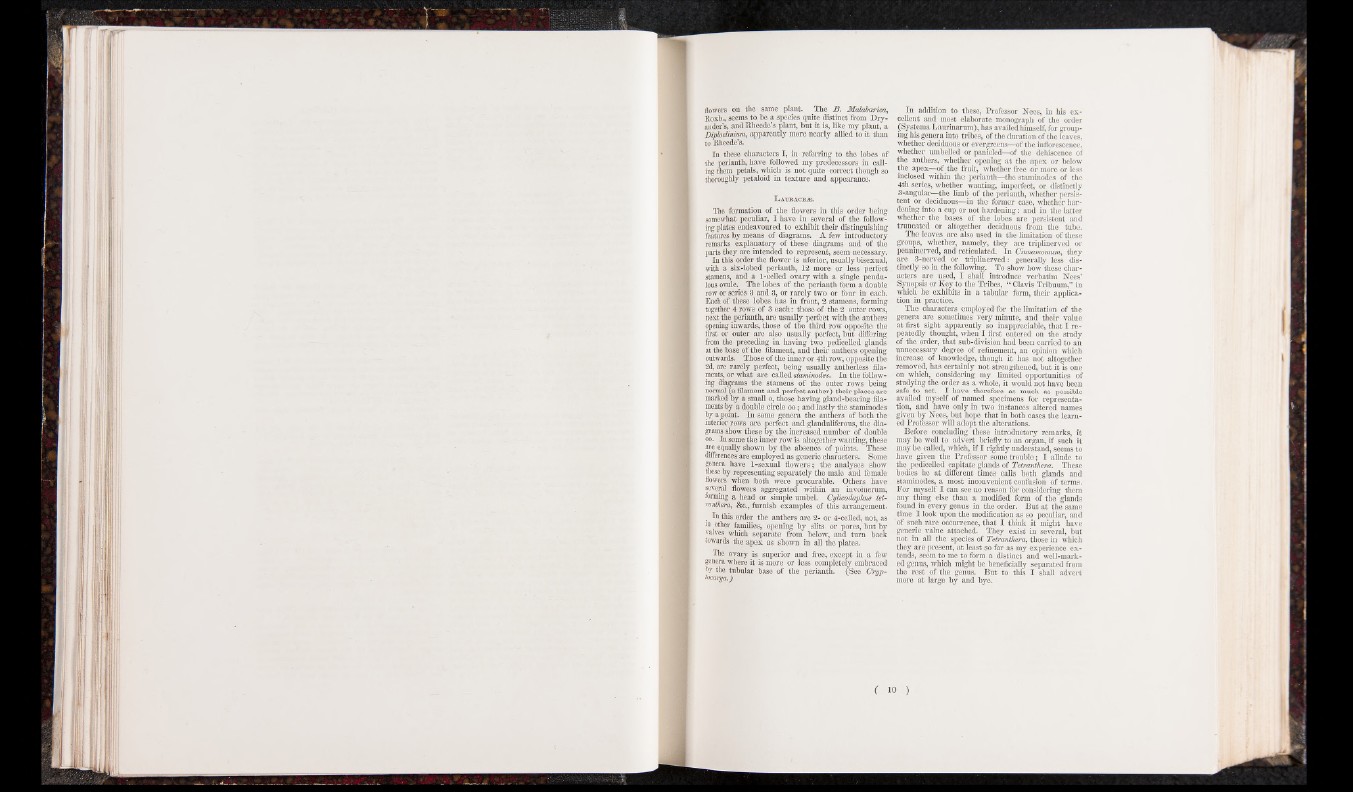
flowers on the same plant. The B . Malabarica,
Koxb., seems to. he a species quite distinct from Dry-
ander’s, and Rheede’s plant, but it is, like my plant, a
Diploclinium, apparently more nearly allied to it than
to Rheede’s.
In these characters I, in referring to the lobes of
the perianth, have followed my predecessors in calling
them petals, which is not quite correct though so
thoroughly petaloid in texture and appearance.
LAUBAcns:.
The formation of the flowers in this order being
somewhat peculiar, I have in several of the following
plates endeavoured to exhibit their distinguishing
features by means of diagrams. A few introductory
remarks explanatory of these diagrams and of the
parts they are intended to represent, seem necessary.
In this order the flower is nferior, usually bisexual,
with a six-lobed perianth, 12 more or less perfect
stamens, and a 1-celled ovary with a single pendulous
ovule. The lobes of the perianth form a double
row or series 3 and 3, or rarely two or four in each.
Each of these lobes has in front, 2 stamens, forming
together 4 rows of 3 each: those of the 2 outer rows,
next the perianth, are usually perfect with the anthers
opening inwards, those of the third row opposite the
first or outer are also usually perfect, but differing
from the preceding in having two pedicelled glands
at the base of the filament, and their anthers opening
outwards. Those of the inner or 4th row, opposite the
2d, are rarely perfect, being usually antherless filaments,
or what are called staminodes. In the following
diagrams the stamens of the outer rows being
normal (a filament and perfect anther) their places are
marked by a small o, those having gland-bearing filaments
by a double circle oo; and lastly the staminodes
by a point. In some genera the anthers of both the
interior rows are perfect and glanduliferous, the diagrams
show these b y the increased number of double
oo. In some the inner row is altogether wanting, these
are equally shown by the absence of points. These
differences are employed as generic characters. Some
genera have 1-sexual flowers; the analyses show
these by representing separately the male and female
flowers when both were procurable. Others have
several flowers aggregated within an invoiucrum,
forming a head or simple umbel. Cylicodaphne tet-
ranthera, &c., furnish examples of this arrangement.
In this order the anthers are 2- or 4-cefled, not, as
m other families, opening by slits or pores, but by
valves which separate from below, and turn back
towards the apex as shown in all the plates.
The ovary is superior and free, except in a few
genera where it is more or less completely embraced
by the tubular base of the perianth. (See Cryp-
tocarya.)
In addition to these, Professor Rees, in his excellent
and most elaborate monograph of the order
(Systema Laurinarum), has availed himself, for grouping
his genera into tribes, of the duration of the leaves,
whether deciduous or evergreens—of the inflorescence,
whether umbelled or panicled—of the dehiscence of
the anthers, whether opening at the apex or below
the apex—-of the fruit, whether free or more or less
inclosed within the perianth—the staminodes of the
4th series, whether wanting, imperfect, or distinctly
3-angular—-the limb of the perianth, whether persistent
or deciduous—in the former case, whether hardening
into a cup or not hardening: and in the latter
whether the bases of the lobes are persistent and
truncated or altogether deciduous from the tube.
The leaves are also used in the limitation of these
groups, whether, namely, they are triplinerved or
penninerved, and reticulated. In Cinnamomum, they
are 3-nerved or triplinerved: generally less distinctly
so in the following. _ To show how these characters
are used, I shall introduce verbatim Nees’
Synopsis or Key to the Tribes, “ Clavis Tribuum,” in
which he exhibits in a tabular form, their application
in practice.
The characters employed for the limitation of the
genera are sometimes very minute, and their value
at first sight apparently so inappreciable, that I repeatedly
thought, when I first entered on the study
of the order, that sub-division had been carried to an
unnecessary degree of refinement, an opinion which
increase of knowledge, though it has not altogether
removed, has certainly not strengthened, but it is one
on which, considering my limited opportunities of
studying the order as a whole, it would not have been
safe to act. I have therefore as much as possible
availed myself of named specimens for representation,
and have only in two instances altered names
given by Rees, but hope that in both cases the learned
Professor will adopt the alterations.
Before concluding these introductory remarks, it
may be well to advert briefly to an organ, if such it
may be called, which, if I rightly understand, seems to
have given the Professor some trouble; I allude to
the pedicelled capitate glands of Tetranthera. These
bodies he at different times calls both glands and
staminodes, a most inconvenient confusion of terms.
For myself I can see no reason for considering them
any thing else than a modified form of the glands
found in every genus in the order. But at the same
time I look upon the modification as so peculiar, and
‘of such rare occurrence, that I think it might have
generic value attached. They exist in several, but
not in all the species of Tetranthera, those in which
they are present, at least so far as my experience extends,
seem to me to form a distinct and well-marked
genus, which might be beneficially separated from
the rest of the genus. But to this I shall advert
more at large by and bye.